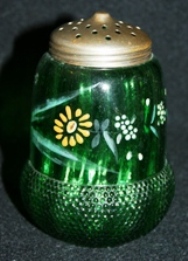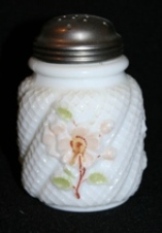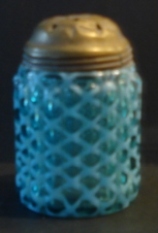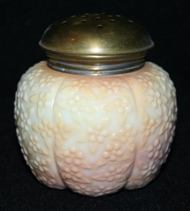Sugar Shakers!
Collecting and studying the American antique glass Victorian sugar shaker, that flourished during the period 1885-1905, was added to our salt shaker club in 2008, precipitating the name change to our current “Antique Glass Salt and Sugar Shaker Club.” While sugar shakers, or “muffineers” as they were known in England, were also made in fine porcelain, ceramic, silverplate and sterling silver, we are primarily interested in the blown glass ones with screw-on tops. William Heacock in his Book III of “Victorian Colored Pattern Glass, Syrups, Sugar Shakers & Cruets From A to Z” comments that they were also called “sugar sifters” or “sugar dusters.” In fact, two 1895 Beaumont Glass ads picture “sugar sifters” in one and “sugar dusters” in the other. A US Glass ad of 1891 pictures one hobnail “shaker sugar or hotel salt.”
American sugar shakers could also be found in cut glass and even majolica, and for a short time were made in pressed glass. After 1905 people began to favor the china sugar shakers. The Victorian sugar shaker tops were pewter or the tin that is frequently found today corroded or split, although Heacock, like the Lechners, advises that the quality of the top should not dictate the value of the glass shaker itself. Heacock reports the sugar shaker was a “passing fancy and often impractical for table usage, so most were put away on a shelf for safe keeping.” He surmises that is why so few sugar shakers are found today with the usual usage and age wear. The Atlanta Antique Gallery gives a brief description of “antique sugar shakers” on their website, recalling the English started the tradition of sprinkling powdered sugar on their morning biscuits, scones and muffins–hence their need for “muffineers.” The Gallery considers sugar shakers to be a “great antique pattern and art glass collectible.”
While Victorian sugar shakers in America were made in many of the popular patterns and colors, some companies made solitary sugar shakers. Among the over 100 examples of sugar shaker shapes/patterns in Heacock’s book, several were produced without any other known table pieces and some were produced in two shapes. Of note are the four different “swirl, opalescent” sugar shaker shapes. It is fun to look through the pages of pictures to find sugar shakers that are identical “big brothers/sisters” to the salt shakers we love. One favorite is a cranberry seaweed. “Rose Pink” by Fostoria is known only made as a sugar shaker and a salt shaker. If members want to seriously add sugar shakers to their collections, Heacock’s book is a must. There are often used copies available on eBay and Amazon.com.
Since 2008 our club newsletter “The Pioneer” has featured articles about both salt and sugar shakers and our conventions have featured matching salt and sugar shakers in advertisements and display categories. Please study the following sugar shaker pictures; some are alone and some are paired with like salt shakers. Other sugar shaker pictures may be found throughout this website to further illustrate the pertinent shaker subject. AGSSSC has also recently begun adding sugar shakers to our educational listing (ID Pages) of unknown shakers for study, identification, and naming.
The shakers pictured below have been chosen because they are familiar favorites of members, are not found in the Heacock book, or are so unique very little is known about them. Some are duplicate pictures of sugar shakers that appear with salt shakers in the convention and special find sections of this website. At present the name of the shaker (if it is known) is captioned below each grouping. Eventually we hope to provide a separate informational page for each shaker!
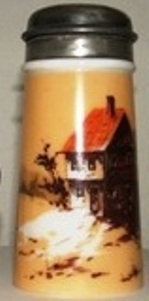

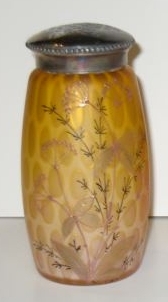
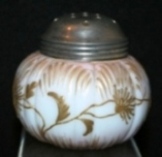
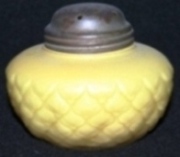

Column 1
Column 2
Column 3
Column 4
Column 5
Column 6

